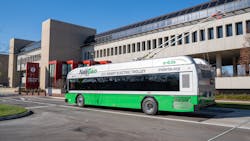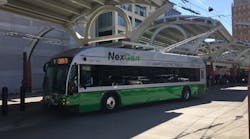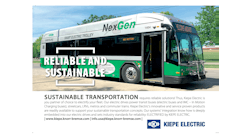Dreams become reality as last innovative NexGen bus rolls into Dayton
Looking down from his office windows with a 360-degree view of the streets below, Greater Dayton Regional Transit Authority (RTA) CEO Mark Donaghy says normally one can “judge my projects by how many binders I have at the end.” But in the case of the agency’s NexGen electric trolley bus system, he doesn’t need the sprawling pile of five-inch binders, stacks of notes, mockups and reports before him to measure the success. Fifteen years of carefully archived information can be verified by glancing out the window as dozens of electric trolleys quietly and effortlessly glide into the makeshift transit center at the corner of Third and Main streets in Dayton, Ohio.
RTA’s main transit center was forced to close for a month at the end of 2020 due to a city road construction project. Normally that would mean pulling the electric trolley buses (ETBs) out of service as they would struggle to divert around the construction. But with the NexGen system, the transition was seamless and likely unnoticed by the agency’s 30,000 daily riders. This was exactly the way Donaghy wanted it.
When Donaghy started his career in Dayton, the agency was in the midst of a financial calamity. Working with a brand-new board of trustees, who made it clear that part of fixing this problem was ensuring RTA’s assets were in good order. That included considering what the agency’s needs were moving forward, particularly as it related to the ETB fleet.
Dayton is one of five agencies in the U.S. operating ETBs. At the time, it had 57 Skoda ETBs purchased between 1996-1998 that would need to be replaced at a price tag of approximately $1 million per vehicle—a major financial undertaking. After working with the University of Dayton to complete a cost/benefit study in 2009, it determined it made financial sense for RTA to continue its electric bus operations. As a result, Donaghy had his senior leaders create a 15- to 20-year plan on replacement of RTA’s rolling stock. In addition, the plan included refurbishing RTA’s 123-mile electric trolley overhead wiring system and that’s when the current Chief Maintenance Officer John Thomas came to Donaghy with an idea the CEO dubbed “John’s magic bus.”
The Skodas came equipped with a battery pack meant to allow the ETB to divert around an accident or other obstruction off-wire for a limited distance.
“In reality, when it worked you could go about three miles an hour, if you weren’t going up a hill, and you could go a short distance and then you would lose your battery pack,” Donaghy said. “John was convinced that the technology had reached the point where we could probably get 20 miles off-wire at 50 miles an hour with a full load of people onboard.”
The process was known as “in-motion charging,” and would allow RTA to expand the system without adding wire. The technology was limitedly deployed in Europe, but not in the United States. Thomas wrote out the project specifications and the original bid package was created in 2011— no one responded.
“I used a different word,” Donaghy said when he reflects on the lack of project interest, “So we thought maybe we needed to sell the concept a little more.”
When Thomas presented his idea to bus builders and suppliers at a conference, most said the ability to run both the bus and charge the battery for future use simultaneously couldn’t be done.
“They looked at me and said, ‘It won’t work and we’re going against physics,’” Thomas recalled. “I said, ‘Well, whoever goes into this with me, we will apply for the Nobel Prize for physics because it will work.”
Undaunted, Thomas said he approached Joe Policarpio, vice president of sales and marketing at Gillig LLC, directly at a conference and explained the concept and the need for a bus manufacturer to partner with Vossloh Kiepe—now Kiepe Electric—a German manufacturer who agreed to make the ETB’s electrical power system and battery. Once Gillig had a concept of what RTA wanted to build, the company was on board, Thomas says, and in 2013 the contract was awarded to Kiepe and Gillig. But that was just the first hurdle.
In 2013, RTA began work with Kiepe and Gillig, ordering four prototypes and an option for up to 70 production units. The hope was the agency would test and perfect this bus within a year and a half. It would be built on the body of Gillig’s compressed natural gas-style coach and loaded with the Kiepe battery pack and an electrical system capable of allowing the bus driver to move the trolley poles on- and off-wire without leaving their seat. But the rigorous testing the NexGen system underwent pushed that timeline to five years.
Everything from ensuring the overhead catenary system had adequate voltage to testing the vehicle structure, safety features and the amount of power it would take to charge the battery, while also running the HVAC systems, lights and windshield wipers on snowy and rainy days were checked. RTA even tested the charging capabilities of these prototypes with bags of sand on-board, representing a fully loaded bus along with every on-board feature running at full power. Anticipating the need for added power to charge the battery and run the traction motor, RTA planned to convert a garage to exclusively host its NexGen fleet which currently has nine substations with plans to add more in the future.
Donaghy says while there were bumps along the way, the completed project was worth it.
“We basically beat the hell out of these buses to make sure that the structure of the bus could handle all the additional weight we were putting on it, especially on the roof,” Donaghy said. “No one liked the delays any less than me, but I think [our board and partners] understood that we were doing what we needed to do. In the end, we got a good product.”
The NexGen system boasts more benefits for RTA’s fleet beyond its ability to drive off-wire, including a low floor that makes it safer and easier to get on and off. The NexGen vehicles are more energy efficient that the previous trolley buses due to the computerized energy management systems on the vehicle and the regenerative braking system assists in re-charging the battery. And since the body and non-propulsion systems are the same as Dayton’s diesel fleet, it also saves the agency time and reduces costs on maintenance.
Despite the COVID-19 pandemic, RTA managed to optimize its resources in order to replace older buses with new ones. In August 2020, U.S. Rep. Mike Turner (R-OH-10)visited RTA to announce a federal grant that would allow them to replace a dozen former models with new diesel buses. And in September, RTA received the final NexGen bus to complete its order of 45 ETBs. As it was off-loaded into the bus garage on Longworth Street, Donaghy said he was anxious to sit in it.
“It was a big feeling of relief,” Donaghy recalled. “Sitting in it, you think this looks like the other 40 that have already gotten here. But it felt really good and there was a great sense of pride.”
When it came to investing in the NexGen and RTA’s ETB system, it was an easy decision, says Deputy CEO Bob Ruzinsky, who helped secure much of the federal grant dollars that kept the project funded.
“When it came time to decide between making an over $100-million investment in Dayton’s long-standing electric trolley bus system versus considering a switch to an all-diesel fleet or another alternative fuel source, it was a no-brainer for RTA,” said Ruzinsky. “The electric trolley buses are clean, quiet, cheaper to operate and an important part of Dayton’s history. Once we determined our vision of marrying the existing technology, using the existing electric overhead wires and combining it with new batteries that can be recharged while the bus is on-wire to extend passenger service when the wire ends, we were full-steam ahead.”
RTA’s maintenance staff describe NexGen as being the “Tesla” of electric trolley buses.
“I enjoy being a part of the technological advancement of trolleys in Dayton. Commercial buses and trucks are not at this stage yet. These are cutting-edge electric trolley buses,” said Daron Brown, RTA’s chief maintenance officer since 2016.
Bus drivers also appreciate the efficiency that comes with the NexGen ETBs. Ron Wilson, a 25-year veteran at RTA, described the NexGen’s dual-mode capabilities as the best of both worlds.
“NexGen has the best features of the diesel, but is still a trolley. They also drive pretty smooth, too. I like it,” he said.
Tom Morrow, a local Dayton-trolley enthusiast, marveled at the impressive functionality of NexGen given his years of experience with former ETBs throughout Dayton’s transit history. He’s ridden and documented as much of Dayton’s trolley history as possible, and agreed the NexGen is at the top of its class.
“It’s revolutionary technology,” he said. “There are no other transit agencies across the country that are operating trolley buses like NexGen, especially considering the distance it covers. It’s remarkable that RTA was able to pull this off.”
The NexGen system is a reminder to the Dayton community of the role electric trolleys buses have served in its history, stretching back more than 100 years. For Donaghy, watching the Route 8 seamlessly navigate around half a dozen detours, some which required a temporary shutdown of RTA’s electrical service, is a part of his legacy.
“My obvious goal is the old saying, ‘leave things better than you found them.’ Here, I was hoping we would accomplish a number of things—probably the two biggest ones were this project, the NexGen, and getting a start on the infrastructure rebuild because that means for the next 50 years, you’re going to have electric transit in Dayton,” said Donaghy.
This continued vision toward the future is what allowed the project to succeed, says Klaus Peter Canavan, president & CEO of Kiepe.
“Working with Mark was great. He put his trust in us to create something unique. Back then [in 2012], most manufacturers were focused on hybrid buses, so this kind of manufacturing could not be found elsewhere. It truly was an all-American project,” Peter Canavan said.
Faith, as well as ingenuity, are not new concepts to Dayton, and both were needed for the NexGen system, says Thomas.
“I knew if the details could be worked out, the bus would work,” he said. “Bob [Ruzinsky] and Mark had to really believe in the program and push it to work through all the issues. It took everybody to get this last bus into service. I cannot even begin to tell you how good it feels.”
Perhaps only one thing remains for this project: applying for that Nobel Prize in physics.
--------------------------
About the authors: Jessica Olson is communications manager and Stephen Mosby is communications specialist for Greater Dayton RTA.







